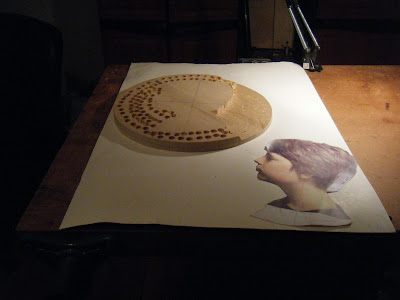
Seven necks. I have been working them as a group, because it is more efficient. The eighth is further along in the process, and I use it as a reminder of what is to be done. Depending on how you count them, there are thirty to fifty operations needed before a neck can be attached to the guitar body. These necks are at step fifteen.

Cameo. A low-relief carving of a head in profile. To the right is the picture from which I work. I am in the process of "raising the field;" that is, cutting away the excess wood over the background. The holes are at a uniform depth, to establish how much should be chiseled off.

Neck Block. This guitar will receive a new neck block. The block shown is the new block, and is about twice the size of the old in. The neck block was replaced to provide enough gluing area to resist the pull of the strings.

Arched Top. The underside of a Sitka Spruce arched top is pictured. I pencil a grid on the surface (the faint lines), and then measure every intersection with a dial gauge. After measuring, I work the thickness down with a round bottom plane, sandpaper, or a scraper. My goal is a uniform thickness of .156.

Resurrection. A guitar I am resurrecting. The body had been completed when humidity changes in the shop caused the thin webs in the sound holes to separate in about eight places. I set it aside back in 2003, and started work on it this year. After taking the back off, , I reinforced the soundhole areas with fine cotton fabric set in epoxy. When the touch-up on the outside is complete, I'll replace the back and complete the guitar.















